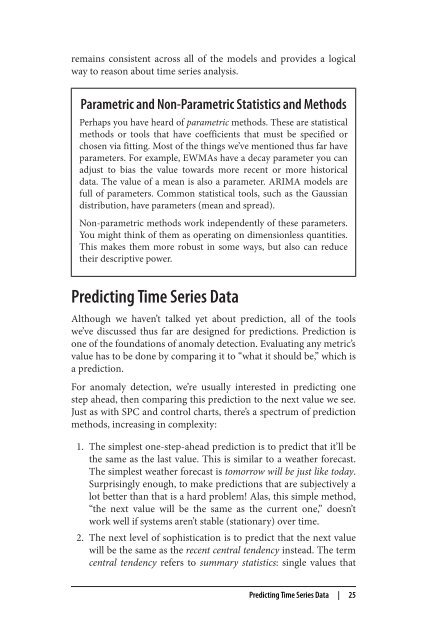Anomaly Detection for Monitoring
anomaly-detection-monitoring
anomaly-detection-monitoring
You also want an ePaper? Increase the reach of your titles
YUMPU automatically turns print PDFs into web optimized ePapers that Google loves.
emains consistent across all of the models and provides a logical<br />
way to reason about time series analysis.<br />
Parametric and Non-Parametric Statistics and Methods<br />
Perhaps you have heard of parametric methods. These are statistical<br />
methods or tools that have coefficients that must be specified or<br />
chosen via fitting. Most of the things we’ve mentioned thus far have<br />
parameters. For example, EWMAs have a decay parameter you can<br />
adjust to bias the value towards more recent or more historical<br />
data. The value of a mean is also a parameter. ARIMA models are<br />
full of parameters. Common statistical tools, such as the Gaussian<br />
distribution, have parameters (mean and spread).<br />
Non-parametric methods work independently of these parameters.<br />
You might think of them as operating on dimensionless quantities.<br />
This makes them more robust in some ways, but also can reduce<br />
their descriptive power.<br />
Predicting Time Series Data<br />
Although we haven’t talked yet about prediction, all of the tools<br />
we’ve discussed thus far are designed <strong>for</strong> predictions. Prediction is<br />
one of the foundations of anomaly detection. Evaluating any metric’s<br />
value has to be done by comparing it to “what it should be,” which is<br />
a prediction.<br />
For anomaly detection, we’re usually interested in predicting one<br />
step ahead, then comparing this prediction to the next value we see.<br />
Just as with SPC and control charts, there’s a spectrum of prediction<br />
methods, increasing in complexity:<br />
1. The simplest one-step-ahead prediction is to predict that it’ll be<br />
the same as the last value. This is similar to a weather <strong>for</strong>ecast.<br />
The simplest weather <strong>for</strong>ecast is tomorrow will be just like today.<br />
Surprisingly enough, to make predictions that are subjectively a<br />
lot better than that is a hard problem! Alas, this simple method,<br />
“the next value will be the same as the current one,” doesn’t<br />
work well if systems aren’t stable (stationary) over time.<br />
2. The next level of sophistication is to predict that the next value<br />
will be the same as the recent central tendency instead. The term<br />
central tendency refers to summary statistics: single values that<br />
Predicting Time Series Data | 25




